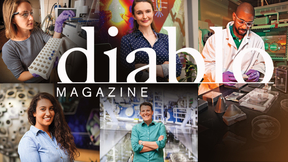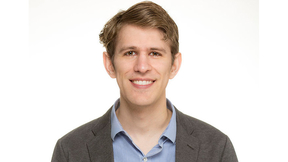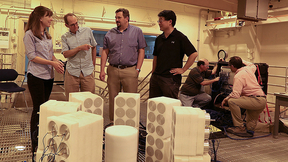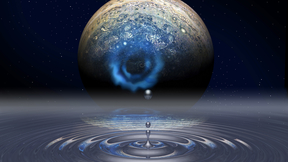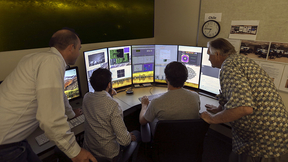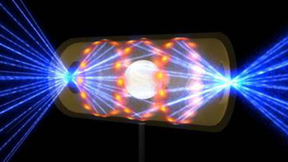Back
Physical and Life Sciences
Hierarchical 3D printing of nanoporous gold could 'revolutionize' electrochemical reactor design
Nanoporous metals are superior catalysts for chemical reactions due to their large surface area and high electrical conductivity, making them perfect candidates for applications such as electrochemical reactors, sensors and actuators. In a study published today in the journal Science Advances, Lawrence Livermore National Laboratory (LLNL) researchers, along with their…
Energy Secretary honors Lab scientist's contributions to stockpile stewardship
Secretary of Energy Rick Perry recognized Lawrence Livermore National Laboratory (LLNL) chemist Bill McLean with a Secretary’s Achievement Award Wednesday in recognition of "pioneering technical contributions that have led to significant advancements in science-based stockpile stewardship." The Secretary’s Honor Awards are bestowed on individuals who have a singular…
Scientists now know the fate of the majority of Higgs bosons particles produced in the LHC
At CERN, the Large Hadron Collider experiments ATLAS and CMS have taken a big step forward in the quest to understand how the Higgs boson enables fundamental particles to acquire mass. The team announced the discovery of the Higgs boson particle transforming into bottom quarks as it decays. This is predicted to be the most common way for Higgs bosons to decay, yet was a…
Five researchers named to '40 Under 40' list
Five Lawrence Livermore National Laboratory (LLNL) researchers join an eclectic group of entrepreneurs, writers, executives, philanthropists and more on Diablo Magazine’s annual "40 Under 40" list, which recognizes young professionals in the East Bay who are leading the charge in their fields. Louisa Pickworth, an experimental physicist and group leader in the Physics…
Victory Through Annihilation: Jason Brodsky’s Neutrinos that Saved the Universe
Jason Brodsky says his work is like “looking for a candle in a raging inferno.” But the Lawrence Livermore physicist believes finding that “candle” could be the key to understanding existence itself. Brodsky’s specialty is rare-event detection, both during his Princeton graduate work on dark matter and his current postdoctoral research at LLNL, in which he searches for…
Learning to love science from gazing at planets
The moment Louisa Pickworth saw the rings of Saturn through her father’s backyard telescope, she knew she wanted to become a scientist to learn "more and more and more." Today, Pickworth, 32, is one of LLNL’s heralded young physicists for her work developing cutting-edge X-ray diagnostics to help scientists learn more about ultrahigh energy physics and inertial confinement…
Four Lawrence Livermore scientists named Distinguished Members of Technical Staff
Four Lawrence Livermore National Laboratory (LLNL) researchers have been named Distinguished Members of Technical Staff (DMTS) for their extraordinary scientific and technical contributions to the Laboratory and its missions, as acknowledged by their professional peers and the larger community. Peter Beiersdorfer and Paul Springer of the Physical and Life Sciences…
Theory aids analysis of nuclear materials
Nuclear emergency teams, safeguards specialists and others may one day benefit from an expanded nuclear fission chain theory and detectors developed by a team of Lawrence Livermore Nationla Laboratory (LLNL) physicists. The Livermore scientists have bolstered their theory for understanding nuclear fission chains -- a cascade of atomic nuclei splitting, each initiated by a…
LLNL and Virginia Tech researchers achieve more complex 3D-printed graphene aerogel
Graphene aerogel is lighter than air but as strong as steel, and it’s already proven useful in aerospace, energy storage and insulation. While there have been recent advances in 3D printing of the novel material, achieving complex structures has been elusive, hampering the unique material’s full potential. To date, 3D printing of graphene aerogel has been done using direct…
Summer scholars learn value of team science
A group of NIF & Photon Science summer scholars and visiting graduate students are experiencing the value of teamwork as they conduct experiments at LLNL’s Jupiter Laser Facility (JLF). Jesus Hinojosa, 26, a University of Michigan graduate student, and Matthew Thibodeau, 21, a Rice University undergraduate, joined a team of veteran scientists and researchers to explore…
National Ignition Facility reveals how hydrogen becomes metallic inside gas giant planets
Swirling dense metallic hydrogen dominates the interiors of Jupiter, Saturn and many extra-solar planets. Building precise models of these giant planets requires an accurate description of the transition of pressurized hydrogen into this metallic substance — a long-standing scientific challenge. In a paper published today by Science, a research team led by scientists at…
Quest for source of black hole dark matter
Like a game of "hide and seek," Lawrence Livermore astrophysicists know that there are black holes hiding in the Milky Way, just not where. If they find them toward the galactic bulge (a tightly packed group of stars) and the Magellanic Clouds, then black holes as massive as 10,000 times the mass of the sun might make up dark matter. If they are only toward the galactic…
Lab researchers find magnetic fields impact atmospheric circulation of gas giant planets
Magnetic fields around a planet or a star can overpower the zonal jets that affect atmospheric circulation. New research by a Lawrence Livermore National Laboratory (LLNL) scientist and a collaborator from the Australian National University (ANU) provides a theoretical explanation for why self-organized fluid flows called zonal jets or "zonal flows" can be suppressed by…
Using microbes to convert CO2 to natural gas
Lawrence Livermore National Laboratory (LLNL), in collaboration with Southern California Gas Co. and Stanford University, are using microbes to convert carbon dioxide directly to renewable natural gas. The U.S. Department of Energy recently awarded the power-to-gas project $800,000. SoCalGas will provide co-funding of $400,000 in addition to $125,000 of seed funding it…
New data sets enhance global climate models
A new initiative by Lawrence Livermore National Laboratory (LLNL) scientists collects, archives and documents climate data sets to support the coordinated modeling activities that study past, present and future climates. The initiative, known as input data sets for Model Intercomparison Projects (input4MIPs), is featured in a recent edition of the American Geophysical…
FDA approves medical device utilizing LLNL-developed shape memory technology
The Food and Drug Administration has approved the use of a medical device in humans for deliberately blocking blood flow to treat bleeding abnormalities or other conditions, a procedure known as embolization. The device integrates expanding shape memory polymer technology that was partly developed at Lawrence Livermore National Laboratory (LLNL). The FDA recently granted…
HED Science Center Hosts Workshop on Nuclear Processes in Dense Plasmas
The Laboratory’s High Energy Density (HED) Science Center hosted a workshop regarding nuclear processes in dense plasmas, providing a forum where members of the HED science and nuclear physics communities could share ideas. The workshop took place on July 30 and August 1, 2018, at LLNL. According to Frank Graziani, director of the HED Science Center, the workshop offered…
Lawrence Livermore chemist elected ACS fellow
Lawrence Livermore National Laboratory (LLNL) chemist Dawn Shaughnessy, whose team helped discover six new elements on the periodic table, has been elected a fellow of the American Chemical Society (ACS). The fellows program began in 2009 to recognize and honor ACS members for outstanding achievements in and contributions to science, the profession and ACS. Shaughnessy is…
Exploring the chemistry of nuclear explosions
To understand fallout formation from a nuclear explosion, it’s important to look at the gas phase of metal oxides within the device. Lawrence Livermore National Laboratory (LLNL) scientists have developed a plasma-flow reactor to experimentally simulate the late cooling of post-detonation fireballs where temperature drops below 10,000 K. They investigate the formation of…
Human influence detected in changing seasons
For the first time, scientists from Lawrence Livermore National Laboratory (LLNL) and five other organizations have shown that human influences significantly impact the size of the seasonal cycle of temperature in the lowest layer of the atmosphere. To demonstrate this, they applied a so-called "fingerprint" technique. Fingerprinting seeks to separate human and natural…





